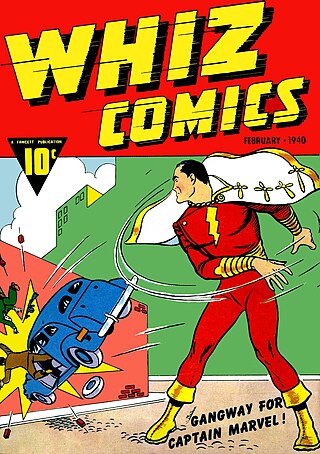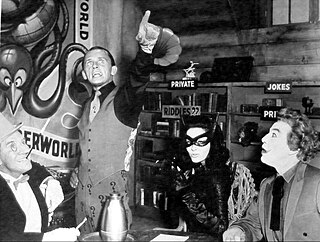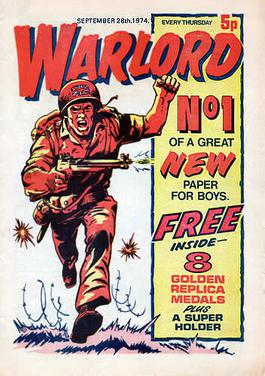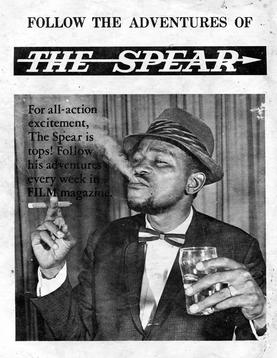
A comic book, also called comicbook, comic magazine or simply comic, is a publication that consists of comics art in the form of sequential juxtaposed panels that represent individual scenes. Panels are often accompanied by descriptive prose and written narrative, usually, dialogue contained in word balloons emblematic of the comics art form.

A superhero or superheroine is a stock character who typically possesses superpowers or abilities beyond those of ordinary people, is frequently costumed concealing their identity, and fits the role of the hero; typically using their powers to help the world become a better place, or dedicating themselves to protecting the public and fighting crime. Superhero fiction is the genre of fiction that is centered on such characters, especially, since the 1930s, in American comic books, as well as in Japanese media.

A stock character, also known as a character archetype, is a type of character in a narrative whom audiences recognize across many narratives or as part of a storytelling tradition or convention. There is a wide range of stock characters, covering people of various ages, social classes and demeanors. They are archetypal characters distinguished by their simplification and flatness. As a result, they tend to be easy targets for parody and to be criticized as clichés. The presence of a particular array of stock characters is a key component of many genres, and they often help to identify a genre or subgenre. For example, a story with the stock characters of a knight-errant and a witch is probably a fairy tale or fantasy.

A supervillain or supercriminal is a variant of the villainous stock character that is commonly found in American comic books, usually possessing superhuman abilities. A supervillain is the antithesis of a superhero.

Black Canary is the name of two superheroines appearing in American comic books published by DC Comics. As one of the earliest female superheroes in the DC Comics universe, the character has made numerous appearances in prominent team-up titles, including the Justice Society of America and Justice League of America. The Black Canary persona has been adopted by two individuals, portrayed as a legacy heroes with a mother-daugher relationship between the two. Following DC's New 52 initiative, Black Canary was briefly alamalgamated as a single character before the mother-and-daughter dynamic was restored to continuity, the history formerly established retroactively added as part of the second Black Canary's history.

The cinema of Nigeria, often referred to informally as Nollywood, consists of films produced in Nigeria; its history dates back to as early as the late 19th century and into the colonial era in the early 20th century. The history and development of the Nigerian motion picture industry is sometimes generally classified in four main eras: the Colonial era, Golden Age era, Video film era and the emerging New Nigerian cinema era.
Dan Spiegle was an American comics artist and cartoonist best known for comics based on movie and television characters across a variety of companies, including Dell Comics, DC Comics, and Marvel Comics.

Cinema of Africa covers both the history and present of the making or screening of films on the African continent, and also refers to the persons involved in this form of audiovisual culture. It dates back to the early 20th century, when film reels were the primary cinematic technology in use. During the colonial era, African life was shown only by the work of white, colonial, Western filmmakers, who depicted Africans in a negative fashion, as exotic "others". As there are more than 50 countries with audiovisual traditions, there is no one single 'African cinema'. Both historically and culturally, there are major regional differences between North African and sub-Saharan cinemas, and between the cinemas of different countries.

Warlord was a comics anthology published weekly in the United Kingdom between 28 September 1974 and 27 September 1986.
Characters native to the African continent have been depicted in comics since the beginnings of the modern comic strip. Initially, such early 20th-century newspaper comics as Winsor McCay's Little Nemo depicted the racist stereotype of a spear-carrying cannibal, a comedic convention of the time. African characters later began to appear as another stereotype, the "noble savage"—a similar progression to that of depictions of Native Americans—and eventually as standard human beings.
Ethnic stereotypes in comics have evolved over time, reflecting the changing political climate.
The portrayal of women inAmerican comic books has often been the subject of controversy since the medium's beginning. Critics have noted the roles of women as both supporting characters and lead characters are substantially more subjected to gender stereotypes, with femininity and/or sexual characteristics having a larger presence in their overall character.

Osuofia in London is a 2003 Nigerian comedy film produced and directed by Kingsley Ogoro, starring Nkem Owoh. The film is arguably one of the highest selling Nollywood films in history. It was followed by 2004 sequel titled Osuofia in London 2.

Superhero fiction is a subgenre of speculative fiction examining the adventures, personalities and ethics of costumed crime fighters known as superheroes, who often possess superhuman powers and battle similarly powered criminals known as supervillains. The genre primarily falls between hard fantasy and soft science fiction in the spectrum of scientific realism. It is most commonly associated with American comic books, though it has expanded into other media through adaptations and original works.
Black people have been portrayed in comics since the medium's beginning, with their portrayals often the subject of controversy. Mainstream comic publishing companies have had a historical trend of being predominantly white and male, reflecting the lack of representation and inaccurate depictions of Black people in comics. The integration of black characters in mainstream and superhero comics has endured various obstacles and challenges. Critics have noted that black men and women have historically often been portrayed as jungle or ghetto stereotypes, and as sidekicks as opposed to primary characters. Occiasionally, comic book creators would lampshade stereotypes, lack of representation and emphasize social injustices. In recent years, with the integration of more Black people in mainstream comic writing rooms as well as the creation of comics on digital platforms has changed the representation and portrayals of Black people in comics and has started to reflect the complexities of Black people across the diaspora.

Lance Spearman is a fictional character created in the mid-60s by Drum Publications. The adventures of Lance Spearman was published in a weekly photo comic that went by the title African Film in East and West Africa and Spear Magazine in South Africa, and was featured in over one hundred and fifty issues. Lance Spearman was widely regarded as the James Bond of English speaking Africa from Kenya on the East Coast to South Africa, and across the West Coast in Nigeria and Ghana. At its zenith, Lance Spearman had over half a million fans across the continent until the series was discontinued in 1972.

Golden Age or Golden era are terms used in Nigerian film history to designate the motion picture industry of Nigeria from the late 1950s to the late 1980s. It captures the mode of visual and sound production, as well as the method of distribution employed during this period. This period began with the formal recognition of the Nigerian Film Unit as a sector in 1954, with the first film entirely copyrighted to this unit being Fincho (1957) by Sam Zebba.

The video film era, also known as the home video era, is a period in Nigerian cinema, typically from the late 1980s / early 1990s to mid 2010s, when Nigerian films were made using affordable video format. The video boom era emerged after the downturn of the Golden era of the Nigerian cinema in the late 1980s. The term "home video" stems from the concept of staying at home to watch the films, in contrast to films of the Golden Age which were watched at the movie theatres.

Nollywood, a portmanteau of Nigeria and Hollywood, is a sobriquet that originally referred to the Nigerian film industry. The origin of the term dates back to the early 2000s, traced to an article in The New York Times. Due to the history of evolving meanings and contexts, there is no clear or agreed-upon definition for the term, which has made it a subject of several controversies.
Stereotypes about Africa, Africans, and African culture are common, especially in the Western World. European imperialism was often justified on paternalistic grounds, casting Africa as less civilised, and Africans as less capable of civilising themselves. These stereotypes can still be seen in today's press.












